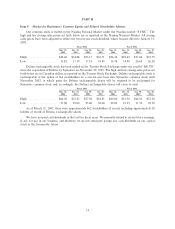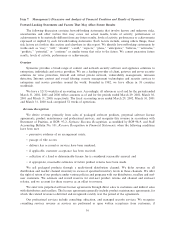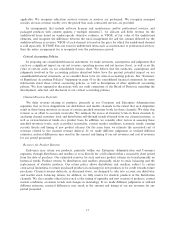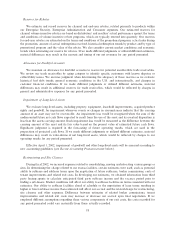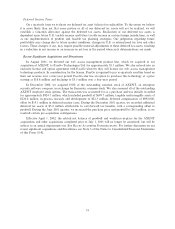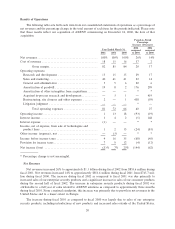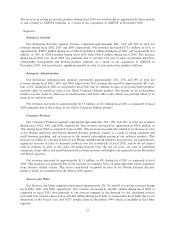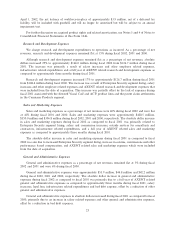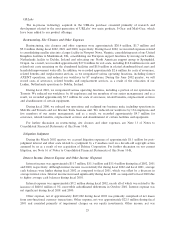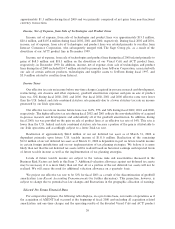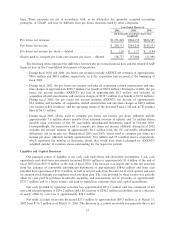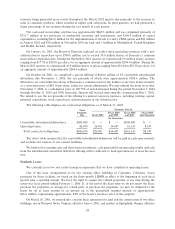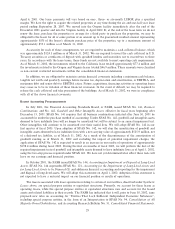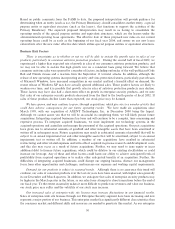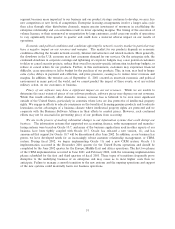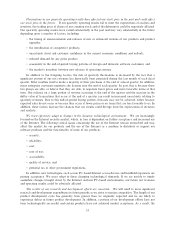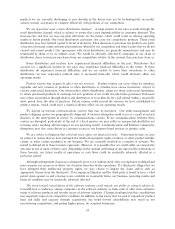Symantec 2002 Annual Report Download - page 46
Download and view the complete annual report
Please find page 46 of the 2002 Symantec annual report below. You can navigate through the pages in the report by either clicking on the pages listed below, or by using the keyword search tool below to find specific information within the annual report.Amortization of Goodwill and Other Intangibles from Acquisitions
Amortization of goodwill and other intangibles from acquisitions increased 176% to approximately
$196.8 million during Ñscal 2002 from $71.3 million during Ñscal 2001, and increased 299% to approximately
$71.3 million during Ñscal 2001 from $17.9 million during Ñscal 2000. These increases were related primarily
to the amortization of goodwill and other intangibles associated with the acquisition of AXENT in December
2000.
EÅective April 1, 2002, the net balance of goodwill of approximately $521.9 million will no longer be
amortized but will be subject to an annual impairment test. As a result, amortization charges will decrease
signiÑcantly going forward; however, our operating results may be subject to increased volatility as a result of
periodic goodwill impairment charges. Other intangibles from acquisitions will continue to be amortized over
their useful lives.
Acquired In-Process Research and Development Expenses
We recorded no acquired in-process research and development charges during Ñscal 2002. During Ñscal
2001, we acquired AXENT and during Ñscal 2000, we acquired URLabs and L-3 Network Security's
operations. We wrote oÅ approximately $22.3 million and $4.3 million of acquired in-process research and
development associated with these acquisitions during Ñscal 2001 and 2000, respectively. These write-oÅs
were necessary because the acquired technologies had not yet reached technological feasibility and there were
no alternative uses.
The eÅorts required to develop the acquired in-process technology principally related to the completion of
all planning, design, development and testing activities that are necessary to establish that the product or
service can be produced to meet its design speciÑcations including features, functions and performance. We
expect the acquired in-process technology to be developed into commercially feasible products. However,
there are no assurances that this will occur. If we fail to complete these products in their entirety, or in a
timely manner, we may not continue to attract new users, we may be unable to retain our existing users and
the value of the other intangible assets may become impaired.
We determined the fair value of the acquired in-process technology for each of the purchases by
estimating the projected cash Öows related to these projects, including the cost to complete the acquired in-
process technologies and future revenues to be earned upon commercialization of the products. We discounted
the resulting cash Öows back to their net present values. We based the net cash Öows from such projects on our
analysis of the respective markets and estimates of revenues and operating proÑts related to these projects.
A valuation specialist used our estimates to establish the amount of acquired in-process research and
development to be written oÅ for these acquisitions during Ñscal 2001 and 2000. Actual spending on these
product development projects since our acquisition of the companies discussed below did not diÅer materially
from the original assumptions and projections discussed in prior Ñlings.
AXENT
The in-process technology acquired in the AXENT acquisition consisted primarily of research and
development related to the next generation of ESM, Intruder Alert, Raptor Firewall, Webthority and other
projects. AXENT's research and development was focused on providing more robust features in its
development of these next generation products. We have added these projects to our product oÅerings, with
the exception of Webthority, which was divested with our web access management product line in
August 2001.
L-3 Network Security
The in-process technology acquired in the L-3 Network Security purchase consisted primarily of research
and development related to the next generation of Retriever and Expert. We have integrated this technology
into our vulnerability management products.
24


